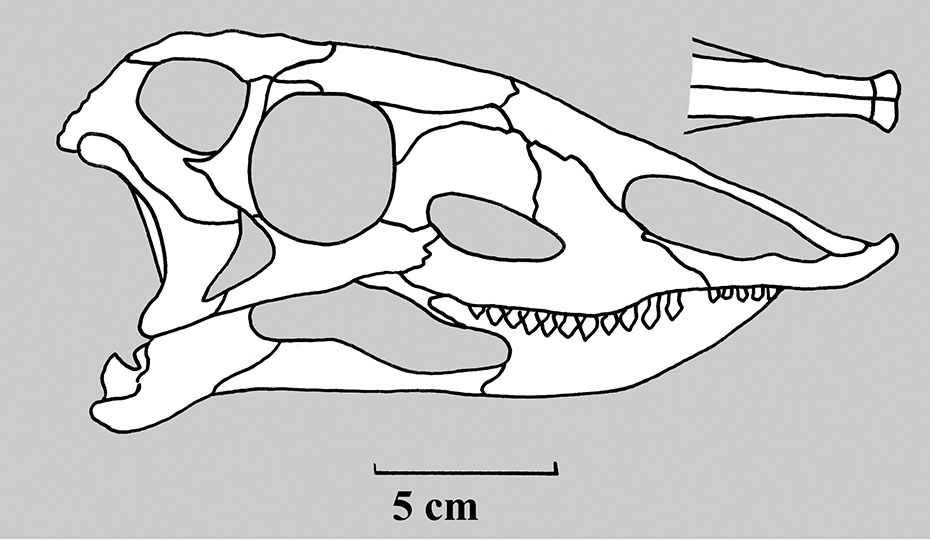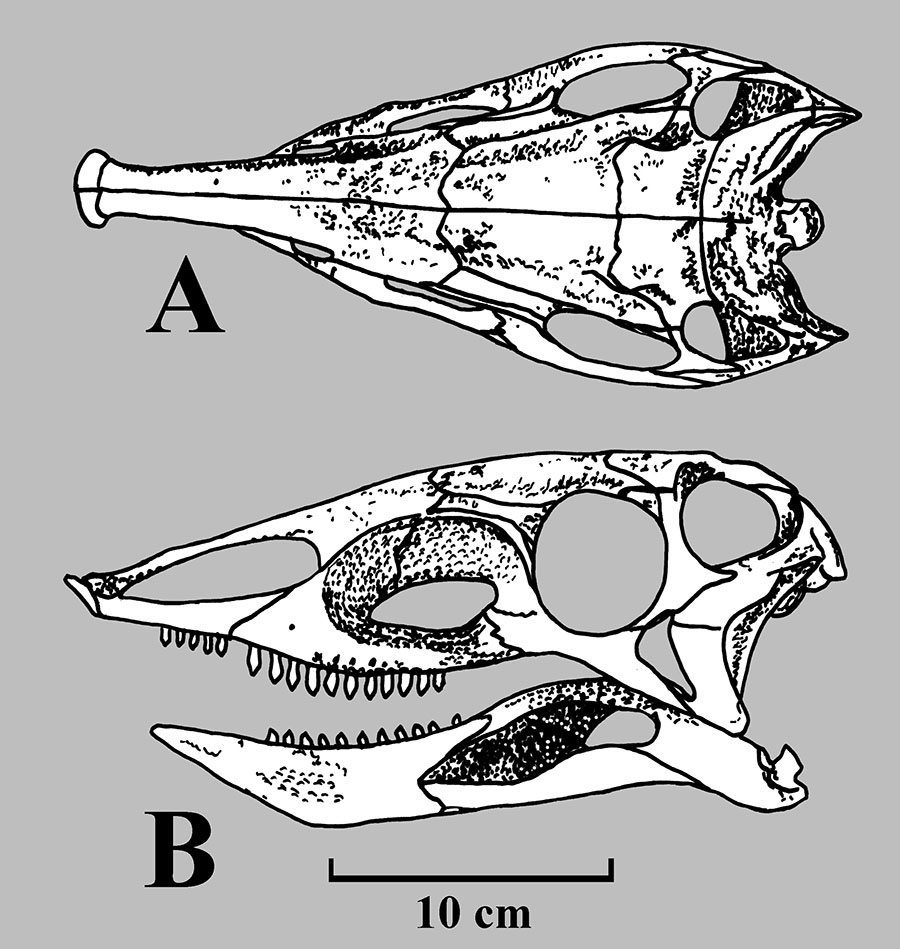EM A, GSM 90855: Femora.
EM 3R: Dorsal rib, chevron, dorsal scute.
EM 5R, 8R, 24R, GSM 90917, MCGD 2, 16, 17, 18, R 4789, R 4790, 4792, R 4803: Dorsal scutes
EM 13W: Manus.
EM 14R: 7th cervical.
EM 15R: Anterior chevron?
EM 18R: Posterior caudal.
EM 20R: Scapula, coracoid, dorsal scutes.
EM 26R: Dorsal rib, femur, manus, fibula.
EM 27W: Anterior caudal.
EM 30R: 8th cervical.
EM 32R: Chevron.
EM 33R: Fibula, paramedian dorsal scute.
EM 33W: Cervical vertebrae.
EM 34R and counterpart BMNH 36399: A small right femur and 2 dorsal vertebrae, femur.
EM 35R: 6th cervical.
EM 37R: Scapula, coracoid.
EM 38R: Premaxilla, portion of nasals and maxilla.
EM 39R: Scapula, coracoid.
EM 44R: Left quadrate.
EM 46R: Ilium, femur.
EM 47R: Caudal vertebrae.
EM 48R: Left pes.
GSE 4794: Fibula.
GSM 37049: Region between middle of external naris and anterior margin of orbit with parts of the jaws, anterior part of palate.
GSM 37050: Region between middle of external naris and anterior margin of orbit with parts of the jaws, anterior part of palate.
GSM 37051: Region between middle of external naris and anterior margin of orbit with parts of the jaws, anterior part of palate.
GSM 58327: Left femur.
GSM 90848: Interclavical.
GSM 90849: Ilium.
GSM 90850: Distorted scapula and coracoid.
GSM 90851: Ischium.
GSM 90853: Apex of scapula, coracoid.
GSM 90854: Radius.
GSM 90857. MCZD 4: Pubes.
GSM 90858: Left humerus.
GSM 90864, 90865: A distorted and incomplete snout, anterior end of dentary and the edentulous region, dentary.
GSM 90863, 90879, 90881: Premaxilla, portion of nasals and maxilla.
GSM 90884: Sacrum, caudal vertebrae.
GSM 90901: Tibia.
GSM 90910: Scapula, coracoid, juvenile.
MCZD 1: Left radius, manus, dorsal scutes.
MCZD 2. An almost complete but crushed skull, atlas and axis crushed, dorsal scutes.
MCZD 3: Distal end of tibia.
MCZD 10: Left pes.
MCZD 13: Left astraglus, crushed tarsus and pes.
R 4784: Hyobranchial skeleton, quadrate and epipterygoid, brain case, 7th cervical to 4 caudal vertebrae, scapula and coracoid, left humerus.
R 4786: Counter part of R 4793. Tibia, left pes.
R 4787: Counter mold to R 4784, dentary.
R 4788: Right ilium.
R 4789: Cervical rib, right ilium.
R 4790: Cervical vertebrae, cervical rib, dorsal rib, ilium.
R 4792: Fibula, left pes.
R 4793: 7th cervical to 4th caudal vertebrae, pubis.
R 4786: Tarsus.
R 4797: Fibula, left pes.
R 4799: Caudal vertebrae, left ischium, dorsal scutes..
R 4808: Ischia.
RSM 1891.92.529: Mid-caudal vertebrae, dorsal scutes.
RSM 1952.10.1: Incompletely exposed but shows the relation of the girdle to the belly-armor, dorsal scutes.
LYDEKKER, 1888
BMNH R582: Dorsal scute and a bone of the foot.
BMNH 27404: Ventral Scutes.
BMNH 36392: 5 imperfect dorsal scutes.
BMNH 36393: Fragments of 2 or 3 scutes.
BMNH 36394: 8 pairs of scutes.
BMNH 36395: Impressions of numerous imperfect scutes.
BMNH 36396: Imperfect scutes or impressions.
BMNH 36397: Impressions of several associated apparently ventral scutes.
BMNH 36398: Slab with part of a large crushed bone.
BMNH 36399: A small scutes and impressions of a femur.
BMNH R581: 2/3rds of left humerus.

After Reyes et al., 2021.

After WALKER, 1961: A) dorsal and B) left lateral views.
BENTON & SPENCER, 1995/PEACOCK et al, 1968
Locality: East Lodge, Findrassie (NJ 207652, NJ 204651), Scotland, Northern United Kingdom.
Horizon: Lossiemouth Sandstone Formation.
Biostratigraphy:
Age: Late Carnian Stage-Early Norian, Lower Late Triassic Epoch, Late Triassic.
Material:
ELGNM
LUCAS, SPIELMANN & HUNT, 2007
Locality: Cement plant claypit at Krasiejow near Opole, Silesia Province, Southern Poland.
Horizon: Drawno Beds.
Biostratigraphy:
Age: Middle to late Carnian Stage, Lower Late Triassic Epoch, Late Triassic.
Material:
PAN ZPAL AbIII 115: Incomplete left femur.
PAN ZPAL AbIII 502/52: Right? metapodial.
PAN ZPAL AbIII 502/67: Mid-dorsal vertebra.
PAN ZPAL AbIII 535: Left lateral osteoderm.
PAN ZPAL AbIII 694: Incomplete left scapulocoracoid.
PAN ZPAL AbIII 1175: Left humerus.
PAN ZPAL AbIII 1178: Left tibia.
PAN ZPAL AbIII 1179: Left ulna.
PAN ZPAL AbIII: 1527: Right? rib.
PAN ZPAL AbIII 1693: Incomplete sacral vertebra.
PAN ZPAL AbIII 57011: Left paramedian osteoderm.
BLASZCZEC & ANTCZAK, 2025
UOPB3645-3649, UOBS00148, 02174, 02258, 92395, 02876: Osteroderms.
ROTHSCHILD, O'CONNOR & LOZADO, 2022
PAN ZPAL AbIII 3315: Ribs with pathologies.
PATON, 1975
Locality: Elgin, Moryshire Province, Scotland, Northern United Kingdom.
Horizon:
Biostratigraphy:
Age: Carnian Stage, Lower Late Triassic Epoch, Late Triassic.
Material:
RSM: 43 assorted bones and scutes.
= Ebrachosaurus singularis KUHN, 1936
Etymology:
Holotype:
Locality: Ebrach, Northeast Bayern (Bavaria) State, Germany.
Horizon: Blasensandstein, Keuper.
Biostratigraphy:
Age: Norian Stage, Late Triassic Epoch, Late Triassic.
Material: Ilium, pubis, proximal right femur, dorsal vertebrae, left ulna, right femur, left humerus, and dorsal scutes.
= Stagonolepis olenkae SULEJ, 2010
Etymology:
Holotype: ZPAL. AbIII/466.17
Locality: Drawno beds, Krasiejow, Opol Silesia, Poland.
Horizon:
Biostatigraphy:
Age: Late Caranian Stage, Late Triassic Epoch, Late Triassic.
Material: Skull roof, and some postcranial material.
Referred material:
DROZDZ, 2018
ZPAL AbIII/2407: Right forelimb, ulna, radius 3 carpal elements, fused radiale and intermedium, ulnare, 1 distal carpal, 10 elements of the manus, all metacarpals, and all phalanges of the 1st row and numerous small ostederms.
ZPAL AbIII/3349/1: Right forelimb, distal end of ulna, distal end of the radius, 4 carpal elements, fused radiale and intermedium, ulnare, 2 distal carpals (probably the distal carpals III - smaller and IV - larger), 16 elements of the manus, all metacarpals, all phalanges of the digits I (1st row phalanx and ungual, all phalanges of digit II (2 phalanges and ungual), broken 1st row phalanx of the digit, 4 phalanges of the forth digit IV (1st, 2nd, 3rd adn 4th row phalanges), 1st row phalanx of the fifth digit, and numerous small ostederms.
ZPAL AbIII/3349/2: Left forelimb, distal end of ulna, distal end with part of the shaft of the radius, 3 carpal elements, fused radiale and intermedium and two other carpals, 10 elements of the manus: all metacarpals and five phalanges 9probably 1st row phalanx of the digit III, 1st and 2nd row phalanges of digits IV and V); numerous small osteoderms.
ZPAL AbIII/2071: Left and right limbs: 4 carpal elements of the right limb, the fused radiale and intermedium, ulnare, 2 other carpals, 14 elemtns of the right manus, all metacarpals, all phalanges of digit I (phalanx and ungual), all phalanges of digit II (1st, 2nd row phalanges and ungual), and probably all phalanges of digit III (1st, 2nd row phalanges and ungual) and probably all phalanges of digit III (1st, 2nd, 3rd row of phalanges and ungual, 2 carpal elements of the left limb; the fused radiale and intermedium and crescent shaped carpal, 8 elements of the left manus, metacarpals I, II and IV, all phalanges of the digit 1 (1st row phalanx and ungual), all phalanges of the digit II (1st, 2nd row phalanges and ungual).
ZPAL AbIII/.257, 1175, 2627: Isolated humeri.
ZPAL AbIII/1100/1, 1179, 2014, 3351: Isoalted ulnae.
ZPAL AbIII2106/s, 2106/4, 1628, 3322: Isolated radii.
ZPAL AbIII/2102: Isolated metacarpal of digit IV.
ZPAL AbIII/267, 3352, 3353: Isolated phalanges.